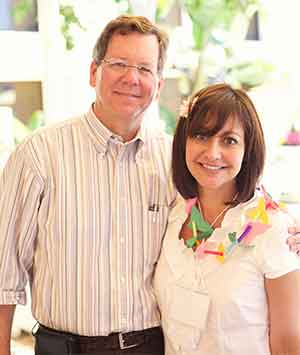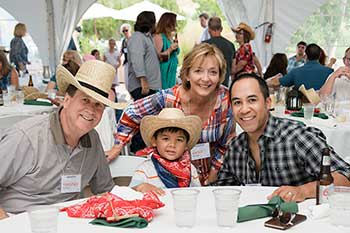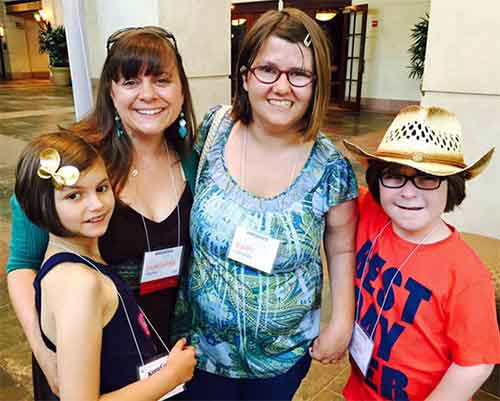Epigraph Vol. 18 Issue 2, Fall 2016
The Brain Recovery Project Focuses On Research And Resources After Pediatric Epilepsy Surgery

Monika Jones (pictured here in 2011 with board member Dr. Gary Mathern) and her husband, Brad Jones, co-founded The Brain Recovery Project. Ms. Jones, an attorney, was the principal investigator on the NIH R 13 grant to partially fund the 2014 scientific workshop on brain plasticity, hemispheric specialization, and neuro-rehabilitation after cerebral hemispherectomy. Her oldest son Henry was born with total hemimegalencephaly and required a hemispherectomy at three months old.
Hemispherectomy for intractable epilepsy in children who have extensive unilateral congenital or acquired abnormalities has had a major beneficial effect on the seizures, with rates of reported seizure freedom between 50 and 80%. Parents of these children are well-informed about the resultant hemiparesis and visual field deficits, but often understand much less about the other, often more subtle deficits that follow the removal of a hemisphere. Although the consequent impairments can be significant, they must be measured against what will occur if the seizures are left uncontrolled — near certain catastrophic regression of intellectual and motor function and possible death. About one-fifth of hemispherectomy patients are gainfully employed and even fewer live independently. There is no doubt that the surgery, when successful, significantly improves the quality of life for patient and family, but families are often left unprepared for the many educational challenges that lie ahead. They often don’t recognize the problems, and, more importantly, they don’t know how to navigate the educational and medical systems to find the needed therapies, if they are even available.
Since 2009, families from around the world impacted by hemispherectomy surgery have gathered annually in various parts of the United States to learn from experts and connect with families on a similar journey. Originally organized by the Hemispherectomy Foundation, the International Hemispherectomy Conference and Family Reunion (fondly referred to as HEMICON) is now solely hosted by The Brain Recovery Project, a U.S.-based not-for-profit corporation which funds new research and provides parents with resources to better understand how they can maximize functional outcomes after pediatric epilepsy surgery.

Children who had hemispherectomy as young as 28 days old were in attendance at this annual two-day conference, as well as adults who had hemispherectomy in childhood (one of whom holds a master’s degree in social work). Physicians and specialists from Colorado Hospital of Colorado, the Craig Hospital, the Coleman Institute for Cognitive Disabilities, and other facilities were presented at the conference.
Because parents often report that they were not fully aware of all the post-operative effects of the procedure, the conference’s main goal is to arm parents and caregivers with the knowledge they need to help their child reach their full potential in all functional areas throughout their lifespan. As part of The Brain Recovery Project’s overall parent education initiative, the conference included sessions to address:
- Vision: Often misunderstood by parents to be only a loss of peripheral vision, homonymous hemianopsia is the loss of the entire visual field opposite the removed hemisphere. This permanent and irreversible visual impairment can have a profound effect on how the child navigates their environment and learns to read. Dr. Robert Enzenauer and Lynn Hellerstein, OD, discussed this impairment and techniques to help children cope with this extensive field loss.
- Hearing: Although children after hemispherectomy will pass a pure tone hearing test, problems with dichotic listening, sound localization, and understanding speech in noise are common because the auditory cortex is removed or disconnected in the procedure. Parents also report misophonia and hyperacusis, sometimes to the point that the child is unable to fully participate in school and social outings. Dr. Frank Musiek, a renowned researcher in the field of central (neural) auditory processing, introduced families to the neuro-anatomical causes of central auditory processing disorders.
- Literacy: One recent paper which addressed functional outcomes after hemispherectomy in a cohort of over 100 children and adults, found that only 43% of children above the age of six could read satisfactorily. The conference included a four-hour educational session to help parents understand U.S. special education law in order to obtain the necessary intensive instructional intervention needed to help their child acquire literacy in school.
- Hydrocephalus: Hydrocephalus after hemispherectomy is a concern throughout the lifespan. A comprehensive, multi-institutional review of 690 patients who had hemispherectomy in childhood found that 20% acquired hydrocephalus after functional hemispherectomy and 30% after anatomical hemispherectomy, with 27% requiring shunts more than 90 days after surgery. Dr. Michael Handler, a collaborator in the study, introduced the group to the dynamics of cerebrospinal fluid and hydrocephalus, as well as explained symptoms of hydrocephalus. This infographic summarizing the study’s findings was also provided to the families.
- Endocrine: Although poorly documented in the research literature, neuro-endocrine challenges after hemispherectomy surgery, including precocious puberty or adrenarche, central diabetes insipidus, and growth issues are reported by families. Dr. Phillip Zeitler introduced parents to the neuro-endocrine system and discussed how brain surgery, hydrocephalus, and brain malformations can affect it.

Other topics were addressed as well, including surgeries to improve hand function and current research on the use of cannabis to control seizures uncontrolled by surgery. A special track for adults who had childhood hemispherectomy was added this year and included workshops on self-advocacy and transitioning to college, as well as a very popular social skills workshop for both teens and adults. By far the most impactful session addressed how a parent can keep their child safe from sexual abuse, an important yet sobering topic for parents of children with intellectual challenges. Because children with an intellectual disability are four times more likely to experience sexual abuse than those without, this session was one of the best-attended sessions at the conference.
Most importantly, the conference provided families with an opportunity to connect in-person with other families they have met on social media with similar etiologies and outcomes. The last night of the conference always includes a grand finale gala and this year was no different. The highlight of the evening was definitely Levon Epsteen’s rendition of "Ain’t No Man" by the Avett Brothers.
Research is also conducted at the conference each year. The UCLA Rare Epilepsies and Brain Disease Tissue Bankcollected saliva from over 70 children and adults with brain malformations to better understand the underlying causes of diseases like Rasmussen’s encephalitis, cortical dysplasia, and other conditions. The University of Minnesota’s Institute of Child Development assessed several children to better understand social and emotional impairments after hemispherectomy. Historically, various researchers have collected data on literacy skills after hemispherectomy surgery.

Primarily focused on post-hemispherectomy functional outcomes for the past several years, The Brain Recovery Project has funded over $200,000 in research at the California Institute of Technology, Rancho Research Institute, Teacher’s College of Columbia, Travis Research Institute, and Rochester Institute of Technology. In 2014, the organization hosted an international workshop on brain plasticity, hemispheric specialization, and neuro-rehabilitation after cerebral hemispherectomy, which brought together researchers and clinicians, funded in part by the National Institutes of Health, and plans to hold this conference triennially. Their collaboration with Rancho Research Institute has produced Robocamp, the world’s first robotics-assisted physical and occupational therapy summer camp for children with similar disabilities.
The Brain Recovery Project also collaborates with the e-NABLE community, with the goal of designing a 3D-printed hand exoskeleton which can help children and adults with hemiplegia use their affected hand. Still in its early design phases, the Airy Arm may soon be an inexpensive solution to help with rough grasp of objects, including soda cans, bicycle handles, and toys.
Researchers interested in working with The Brain Recovery Project should contact Monika Jones, President and Co-founder, at mjones@brainrecoveryproject.org.
Ms. Jones, an attorney, was the principal investigator on the NIH R 13 grant to partially fund the 2014 scientific workshop on brain plasticity, hemispheric specialization, and neuro-rehabilitation after cerebral hemispherectomy. Her oldest son, Henry, was born with total hemimegalencephaly and required a hemispherectomy at three months old.
Subscribe to the ILAE Newsletter
To subscribe, please click on the button below.
Please send me information about ILAE activities and other
information of interest to the epilepsy community